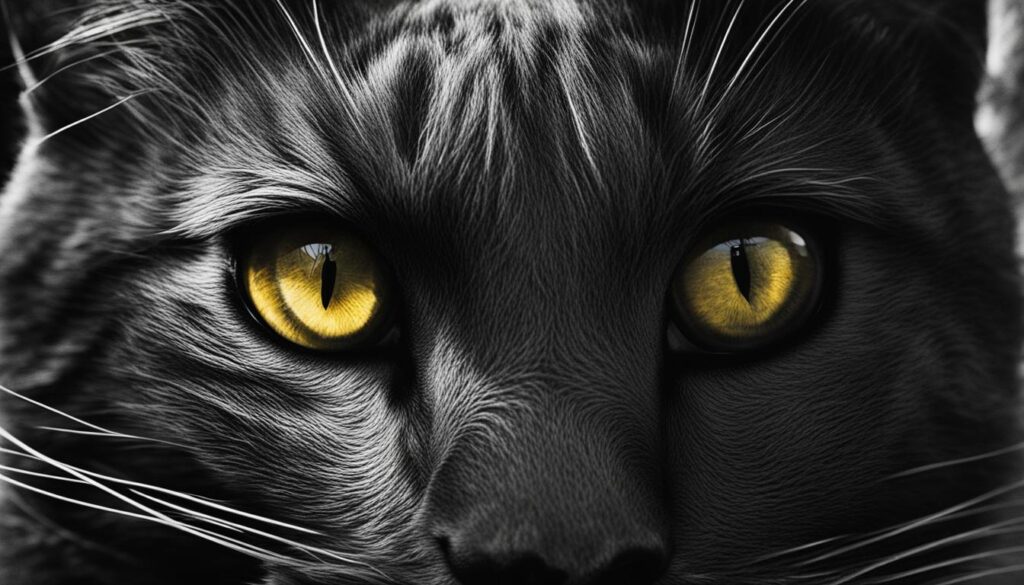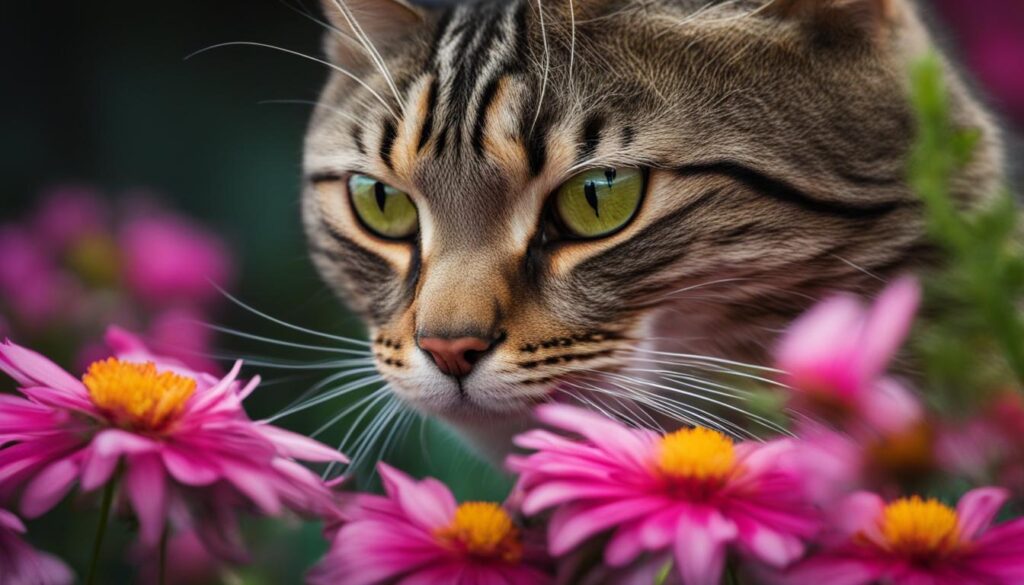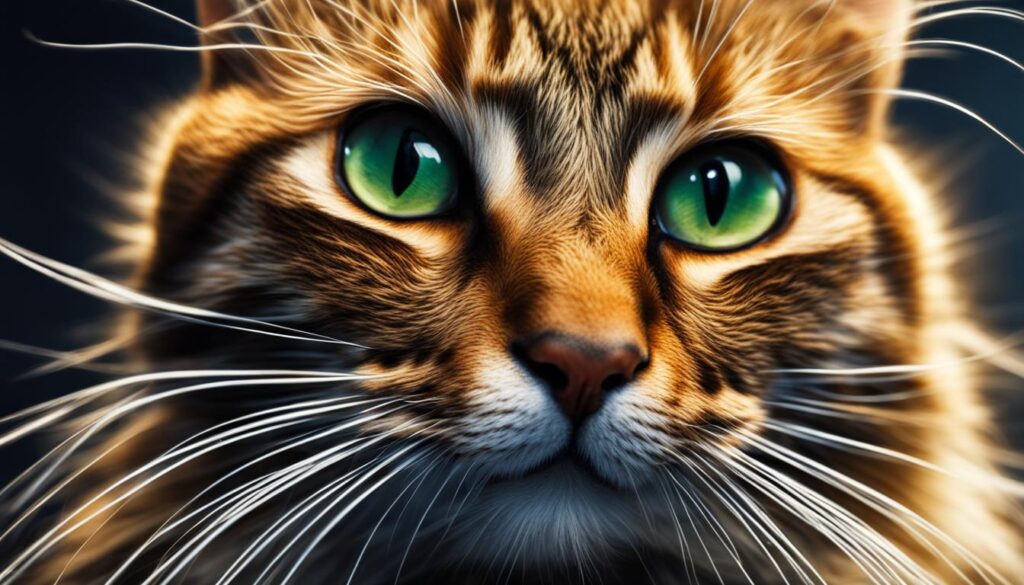Cats and Their Incredible Senses: Seeing, Hearing, and Smelling the World
Cats are fascinating creatures with an array of unique sensory abilities that contribute to their remarkable perception of the world. Their senses of vision, hearing, and smell are finely tuned to help them navigate, hunt, and interact with their environment. Understanding how cats use these senses can provide us with a deeper appreciation for their extraordinary sensory capabilities.
In this article, we will dive into the mesmerizing world of cat senses, exploring how their vision, hearing, and smell contribute to their daily lives. We will uncover the secrets behind their exceptional night vision, their acute sense of hearing, and their extraordinary olfactory expertise. By delving into these fascinating aspects of feline sensory perception, we can gain a greater understanding of the world as cats experience it.
Key Takeaways:
- Cats possess remarkable sensory abilities, including sharp vision, acute hearing, and a highly developed sense of smell.
- Their night vision is superior to humans, thanks to a special reflective layer in their eyes.
- With their sensitive ears, cats can detect sounds beyond the range of human hearing.
- Cats have approximately 200 million odor sensors, allowing them to identify people and objects through scent.
- Whiskers play a crucial role in a cat’s sense of touch and help them navigate their environment.
The Power of Feline Vision
Cats possess extraordinary visual abilities that allow them to see the world in ways that humans cannot. Their unique feline vision is a testament to their incredible sensory capabilities. While humans rely heavily on daylight for visual perception, cats have adapted to be masters of the night.

In low-light environments, a cat’s eyes truly shine. Their eyes contain special layers that reflect light, giving them superior night vision. This is thanks to a structure called the tapetum lucidum, which enhances their ability to see in the dark by amplifying available light.
Furthermore, cats are known for their exceptional depth perception. Their eyes are strategically positioned on the front of their heads, providing them with overlapping fields of view. This overlapping vision allows them to accurately judge distances and accurately pounce on their prey.
Another remarkable feature of a cat’s visual system is their knack for tracking moving objects. Cats have an impressive ability to focus on fast-moving targets, such as a darting mouse or a fluttering bird. Their eyes are adept at tracking motion, which is attributed to their quick reflexes and agile hunting instincts.
While cats excel in low-light conditions, their vision during daylight hours may not be as sharp as humans’. Nevertheless, cats rely heavily on their keen eyesight to navigate their surroundings, spot potential dangers, and stalk their prey.
The Acute Sense of Hearing
Cats possess an acute sense of hearing that surpasses that of humans. Their highly sensitive ears enable them to detect sounds that are outside the range of human hearing. This remarkable ability allows cats to navigate their environment and stay aware of potential threats.
One of the reasons cats excel in hearing is their ability to pick up higher pitches. They can discriminate between different tones and pitches with excellent precision, making them adept at detecting faint sounds and subtle changes in their auditory surroundings.
The large, perky ears of cats play a vital role in their sense of hearing. These flexible ears can swivel independently, allowing cats to pinpoint the exact location of sounds. This remarkable feature enhances their hunting abilities and ensures they remain alert to any potential dangers.
Here’s a glimpse of how a cat’s hearing compares to that of humans:
| Aspect | Cats | Humans |
|---|---|---|
| Hearing Range | Higher pitches and sounds outside human range | Between 20 Hz – 20,000 Hz |
| Directional Hearing | Can pinpoint the source of sounds with precision | Relatively accurate, but not as sensitive as cats |
| Noise Sensitivity | Highly sensitive, can be startled by loud noises | Varies among individuals |
As seen from the table above, cats have a broader hearing range, enabling them to detect higher frequencies and sounds that are inaudible to humans. This heightened sense of hearing contributes to their exceptional hunting abilities and overall awareness of their environment.
The evasion instincts of cats are also influenced by their acute sense of hearing. They can quickly detect the slightest rustle or movement, allowing them to react swiftly or take cover if necessary.
Take a moment to appreciate the incredible auditory skills of our feline companions.
A cat’s acute sense of hearing helps them stay aware of their surroundings and hunt with precision.
The Olfactory Expertise of Smell
When it comes to the sense of smell, cats are truly extraordinary. Their olfactory abilities surpass those of humans by approximately 14 times. With over 200 million odor sensors in their noses, cats have a remarkable capacity to identify people and objects through scents. This heightened sense of smell enables them to gather information about their environment and establish a deeper understanding of the world around them.
“A cat’s sense of smell is like a superpower,” says Dr. Emily Thompson, a renowned feline behaviorist. “They can detect the tiniest molecules in the air, allowing them to discern intricate details about their surroundings.”
Cats also possess a unique scent-detecting organ called the Jacobson’s organ, located in the roof of their mouth. This organ enhances their ability to detect and analyze smells, particularly those related to pheromones. When a cat curls back its upper lip and opens its mouth slightly, it is engaging the Jacobson’s organ to analyze scents in greater detail.
“The Jacobson’s organ is like a built-in chemical detector,” explains Dr. Thompson. “By utilizing this organ, cats can gain a deeper understanding of their environment, communicate with other cats, and even detect potential mates or prey.”
Understanding the importance of a cat’s sense of smell is crucial for providing them with a stimulating and enriching environment. The use of scented toys, interactive games, and cat-friendly spaces can help stimulate their olfactory senses and provide mental stimulation.
Cats and Odor Preferences
Each cat has its own unique odor preferences. They are highly sensitive to certain scents and may be drawn towards or repelled by specific aromas. Some common scents that cats are known to respond positively to include catnip, silver vine, and valerian root. These scents can promote playfulness and provide a source of entertainment for cats.
On the other hand, there are scents that cats tend to avoid. Strong-smelling cleaning products, citrus, and certain essential oils such as lavender or eucalyptus can be unpleasant for cats and may even be harmful to their health. It is essential to be mindful of the scents we introduce into a cat’s environment to ensure their well-being and comfort.
| Scent | Effect on Cats |
|---|---|
| Catnip | Attracts, stimulates, and excites cats |
| Silver Vine | Provides a euphoric response and encourages playfulness |
| Valerian Root | Induces a calming effect and relaxation |
| Citrus | Tends to repel cats due to its strong scent |
| Lavender | May be off-putting to cats and can cause adverse reactions |

As you can see, a cat’s sense of smell is truly remarkable. It allows them to navigate their surroundings, communicate with other cats, and experience the world in a way that is inaccessible to us. By understanding and respecting their olfactory expertise, we can provide an environment that caters to their sensory needs and enriches their lives.
The Sense of Touch and Whiskers
Cat’s sense of touch is essential for their survival. Whiskers, also known as vibrissae, act as touch receptors that help cats navigate their environment and measure distances accurately. Whiskers are not only found on the face but also on the front legs, which were crucial for hunting and chasing prey in the past. Additionally, a cat’s entire body, including its paws and fur, contributes to its sense of touch.

Whiskers: The Ultimate Navigation Tool
Whiskers are far more than just facial decorations for our feline friends. These long, stiff hairs are packed with nerve endings and act as sensory organs that help cats map and explore their surroundings. When a cat brushes against an object, the whiskers bend and send signals to the nervous system, providing them with valuable information about the object’s size, texture, and movement.
“Whiskers are essential for cats to determine if they can fit through narrow spaces and to judge the distance when leaping or pouncing on prey.” – Dr. Amanda Johnson, Animal Behaviorist
Cats also use their whiskers to gauge whether they can fit into tight spaces or squeeze through narrow gaps. This tactile information, combined with their sharp eyesight, allows them to maneuver with precision and confidence.
The Role of Touch in Communication
Touch plays a significant role in cat-to-cat and cat-to-human communication. You may have noticed that when cats are comfortable and content, they often rub their heads or bodies against people or objects. This behavior, known as bunting, is a form of tactile marking. By leaving their scent behind, cats mark their territory and communicate their presence to others.
Cats also use touch as a means of social bonding. When cats engage in mutual grooming, they not only clean each other’s fur but also strengthen their social bonds. This action promotes trust and cooperation among feline companions.
Respecting a Cat’s Sense of Touch
Understanding and respecting a cat’s sense of touch is essential for responsible pet ownership. Avoid grabbing or touching a cat’s whiskers, as it can cause discomfort or pain. Allow your cat to rub against you or objects for scent marking purposes, as it is a natural behavior that helps them feel secure in their environment.
Creating an enriched environment with various textures, such as scratching posts, soft blankets, and different surfaces, can also stimulate a cat’s sense of touch and provide sensory satisfaction.
Comparing Cat Senses to Humans
While humans have well-developed senses, cats’ senses are specialized for their unique needs. Cats have a more acute sense of smell, allowing them to navigate and identify objects through scents. Cats also have superior night vision, but their daytime vision is not as sharp as humans’. Their hearing is more sensitive and can detect higher frequencies and locate the source of sounds more precisely. However, humans have a broader range of taste buds compared to cats.
The Mysterious Sixth Sense
While there is no scientific evidence to support the idea of a cat’s sixth sense, many cat owners have observed their pets exhibiting seemingly mysterious behaviors. Some believe that cats have a unique ability to predict imminent danger or communicate with unseen forces. While this remains a topic of fascination, there is conclusive evidence of the positive effects that cats can have on individuals with autism or dementia, showcasing their special connection with humans.
Comparing Behaviors
| Cat’s Behaviors | Interpretation |
|---|---|
| Sudden alertness or staring into space | Perception of unseen danger or presence |
| Purring or kneading | Calming and soothing effect on humans |
| Acting skittish or darting around the room | Suspecting hidden threats or disturbances |
Conclusion
As we have seen, cats possess an extraordinary sensory system that allows them to perceive the world in ways that are beyond human comprehension. Their feline sensory perception is truly remarkable, with their vision, hearing, smell, and touch working together to create a sensory experience that is unique to them.
One of the most fascinating aspects of a cat’s sensory system is their eyesight. With their specially adapted eyes, cats are able to navigate and hunt effectively, even in low-light conditions. Their cat eyesight, especially their night vision, is far superior to ours, making them supreme hunters in the animal kingdom.
But it’s not just their vision that sets them apart. Cats also have an incredibly acute auditory system, allowing them to hear sounds that are beyond our range of perception. Their finely tuned ears and ability to locate the source of a sound with precision make them exceptional hunters and alert companions.
And let’s not forget about a cat’s sense of smell, which is approximately 14 times better than our own. Their feline sensory organs, including the Jacobson’s organs, enable them to detect and analyze scents in a way that is simply astonishing. Whether it’s identifying people, objects, or even potential prey, cats rely heavily on their sense of smell to navigate their surroundings.
In conclusion, understanding cat senses gives us a glimpse into the fascinating world of these captivating creatures. Their feline sensory system is a testament to their adaptability and survival skills, allowing them to thrive in a world that is rich with stimuli. Being aware of their unique sensory perception adds to our appreciation of these incredible beings that share our lives.
FAQ
What are cat senses and how do they work?
Cats possess an array of senses, including vision, hearing, smell, taste, and touch. These senses allow them to navigate and perceive their environment. Their vision is particularly adapted for low-light environments, while their hearing is highly sensitive and can detect a wide range of frequencies. Cats also have an exceptional sense of smell, which helps them identify objects and individuals through scents. Their whiskers act as touch receptors and aid in navigating their surroundings.
How is a cat’s vision different from humans?
Cats have superior night vision and can see in near-total darkness, thanks to special layers in their eyes that reflect light. However, their daytime vision may not be as sharp as humans’. Cats’ eyes are adapted for hunting and tracking moving objects, enabling excellent depth perception and the ability to focus on fast-moving prey.
Can cats hear things that humans can’t?
Yes, cats have highly sensitive ears and can hear sounds beyond the range of human hearing. They can detect higher pitches and discriminate between different tones and pitches with great precision. Their large, perky ears, which can swivel independently, help them locate the sources of sounds.
How good is a cat’s sense of smell?
Cats have an extraordinary sense of smell, approximately 14 times more powerful than that of humans. They possess over 200 million odor sensors in their noses, allowing them to identify individuals and objects through scents. Cats also have a secondary scent sensor called the Jacobson’s organs, located in the roof of their mouth, which enhances their ability to detect and analyze smells.
Why do cats have whiskers, and how do they use them?
Whiskers, also known as vibrissae, act as touch receptors for cats. They help cats navigate their environment, measure distances accurately, and detect air movements, such as changes in air pressure. Whiskers are not just found on the face but also on the front legs, aiding in hunting and chasing prey.
How do cat senses compare to human senses?
Cats have a more acute sense of smell compared to humans. While humans have a broader range of taste buds, cats have a superior sense of hearing, allowing them to detect higher frequencies and locate the source of sounds more precisely. In terms of vision, cats have excellent night vision but may not have the same sharpness in daylight compared to humans.
Do cats have a sixth sense?
While there is no scientific evidence to support the idea of a cat’s sixth sense, many cat owners have observed their pets exhibiting seemingly mysterious behaviors. Some believe that cats have a unique ability to predict imminent danger or communicate with unseen forces. However, this remains a topic of fascination and further research.
What can we conclude about cat senses?
Cats possess an array of extraordinary senses that allow them to perceive the world in ways humans cannot. Their vision, hearing, smell, and touch play crucial roles in their daily lives, helping them navigate, hunt, and interact with their surroundings. Understanding cat senses helps us appreciate their fascinating nature and their unique abilities.


